小学新标准英语(一起)第9册教案
英语外研新标准(一起)四年级下册-Module 9 Unit 1 (说课稿)

英语外研新标准(一起)四年级下册-Module 9 Unit 1 (说课稿)一、教材背景《英语外研新标准(一起)四年级下册》是按照新课程标准编写的教材,适用于小学四年级下学期的英语教学。
其中,Module 9包括四个单元,分别是Unit 1《Where’s my pencil ?》、Unit 2《I’m hungry.》、Unit 3《What are you going to do?》和Unit 4《What’s the weather like?》。
本次说课主要针对Module 9中的Unit 1进行讲解。
二、教学目标1.知识目标:学生能够学习家具名称,能听懂并使用动词短语“is on”、“is under”和“is in”简单的位置描述。
2.能力目标:培养学生的听力、口语和阅读能力,提高学生的语言输出能力。
3.情感目标:通过对生活进行简单的描述,让学生学会自我表达,提升他们的口语表达能力和交际能力,同时,培养学生的爱好,发扬英语学习的兴趣。
三、教学重点1.学习家具名称。
2.学会运用“is on”、“is under”和“is in”进行简单位置描述。
四、教学难点学生辨别不同家具的名称,能清晰地描述出家具的位置。
五、教学内容及过程1. 热身引入(5分钟)通过播放英文儿歌《This is the way》唤起学生们的学习兴趣和积极性,逐步进入课堂学习状态。
老师可以先让学生跟读儿歌词,后唱跟动作,拓展生词(如:brush teeth、wash face),为后面学习家具名称做铺垫。
2. 新课讲解(15分钟)1.呈现家具图片,老师帮助学生们辨认,教学家具名称,如:desk、bed、bookcase等。
2.具体地介绍“is on”、“is under”和“is in”三个英文表达,在家具画面上讲解三个表达的用法,并且通过一些实物进行引申,如:the book is on the desk、the cat is under the bed等。
外研版小学英语(新标准一起)五年级下册全册教案
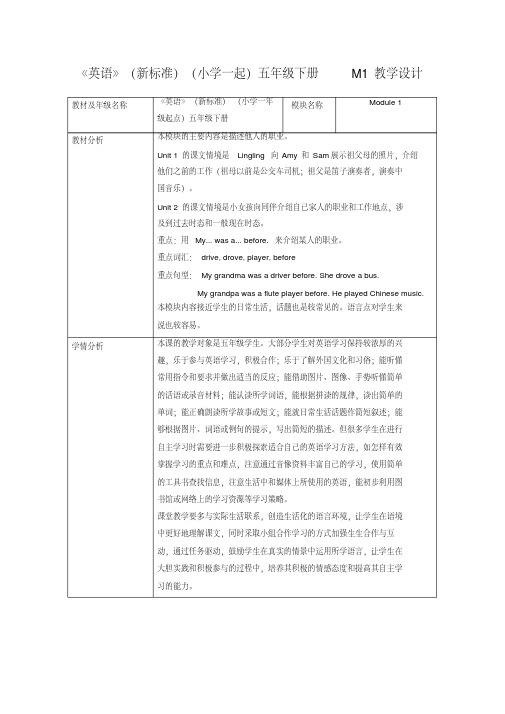
《英语》(新标准)(小学一起)五年级下册M1教学设计模块名称Module 1教材及年级名称《英语》(新标准)(小学一年级起点)五年级下册教材分析本模块的主要内容是描述他人的职业。
Unit 1的课文情境是Lingling向Amy和Sam展示祖父母的照片,介绍他们之前的工作(祖母以前是公交车司机;祖父是笛子演奏者,演奏中国音乐)。
Unit 2的课文情境是小女孩向同伴介绍自己家人的职业和工作地点,涉及到过去时态和一般现在时态。
重点:用My... was a... before. 来介绍某人的职业。
重点词汇:drive, drove, player, before重点句型:My grandma was a driver before. She drove a bus.My grandpa was a flute player before. He played Chinese music.本模块内容接近学生的日常生活,话题也是较常见的。
语言点对学生来说也较容易。
学情分析本课的教学对象是五年级学生。
大部分学生对英语学习保持较浓厚的兴趣,乐于参与英语学习,积极合作;乐于了解外国文化和习俗;能听懂常用指令和要求并做出适当的反应;能借助图片、图像、手势听懂简单的话语或录音材料;能认读所学词语,能根据拼读的规律,读出简单的单词;能正确朗读所学故事或短文;能就日常生活话题作简短叙述;能够根据图片、词语或例句的提示,写出简短的描述。
但很多学生在进行自主学习时需要进一步积极探索适合自己的英语学习方法,如怎样有效掌握学习的重点和难点,注意通过音像资料丰富自己的学习,使用简单的工具书查找信息,注意生活中和媒体上所使用的英语,能初步利用图书馆或网络上的学习资源等学习策略。
课堂教学要多与实际生活联系,创造生活化的语言环境,让学生在语境中更好地理解课文,同时采取小组合作学习的方式加强生生合作与互动,通过任务驱动,鼓励学生在真实的情景中运用所学语言,让学生在大胆实践和积极参与的过程中,培养其积极的情感态度和提高其自主学习的能力。
小学英语新外研版(一起)六年级上册Module 9教案

小学英语新外研版(一起)六年级上册Primary Grade Six NSE Book XI Teaching PlansModule 09●Teaching aims for this Module:1. To learn and be able to use these expressions:Do you want to visit the UN building? Yes, please.Does she/he/it like …ing?What does he/ she/ it/ like …ing?2. To learn and memorize the new words in this module:Peace world kangaroo(分层目标)For most students, they are required to use the words in situations.3. Function: Being able to ask and answer about Do you want to visit the UN building? Yes, please.Does she/he/it like …ing?What does he/ she/ it/ like …ing?4. Using English abilities:1) Make a survey.Inquire students about where did they travelPractice: ask and answer with your deskmate.2) Make up a dialogueWrite and tell the dialogue.3) Being able to introduce the places they had been to.4) Activity Book.5. Emotional aims:After this module’s study, students can ask others if they want to go to some places.Period One●Teaching aims:1. Being able to read the words in Module 9.Peace world kangaroo2. Being able to use the words in a few situations.3. Through practice, be familiar with these expressions in Module 9.Do you want to visit the UN building? Yes, please.Does she/he/it like …ing?What does he/ she/ it/ like …ing?●Teaching steps:1.Write the words on the blackboard.Peace world kangarooSs: Who can read this word?Invite him/ her to read and to show others how to read.T: Give them some necessary help and rules about reading the words.2. Use the words in different situations.1)peace: All the Chinese people love peace.2)world: One world , one dream.3)kangaroo: There are lots of kangaroos in Australia.4) Encourage students to use different expressions to practice these new words.Homework1. Read and write the new words and Chinese meaning in your exercises books.2. Pre-read the dialogues and passges in Unit 1 and 2.Reflection单词较少,所以我把相关的文化知识、句型知识补充进去,对但此进行拓展性学习,运用性练习。
小学英语(三年级起)第一册Module 9 Family Unit 1 This is my mother.教案附教学反思

小学英语(三年级起)第一册Module 9 Family Unit 1 This is my mother.教案附教学反思教材分析1.本课是外研版新标准小学英语(供三年级起始用)第一册Module 9 Family unit1 this is my mother 的教学内容。
主要是对家庭成员的认识,向他人介绍自己的家庭成员和他们的职业。
本课在整个教材中有承前启后的作用,是第六模块this is my句型的延续,是为本模块第二单元的学习做铺垫。
2.通过利用单词卡片、图片,角色扮演等对本单元的知识进行有效的学习。
学情分析1.本册书是小学三年级学生使用,他们是八九岁的孩子,对英语学习很感兴趣,对知识是很渴望的,学习的积极性是非常的高模仿能力也非常强,对歌唱、游戏、图片等直观教学很感兴趣。
2.学生能够运用一些简单的日常交际用语进行相互问候且表演欲较强。
3.由于学生刚接触英语,单词量的掌握有限,对英语没有系统的学习不利于他们对知识的记忆和运用。
教学目标1、知识目标:能够认读家庭成员的单词:Mother, father. Sister, brother, grandpa, grandma 和认读职业的单词,teacher, doctor。
2、能力目标:培养学生运用this is my…,she/he is a…句型向他人来介绍自己的家庭成员。
3、情感目标:培养学生学习英语的兴趣,和对自己家人的热爱。
教学重点和难点1. 词汇:mother, father, sister, brother, grandma, grandpa, teacher, doctor.2. 功能句型:This is my…,he/she is a….3. 学生能够灵活运用本课词汇到功能句上的空缺位来介绍自己家庭成员。
1. 用英文问侯家里有哪些成员。
再翻译。
2.a.今天我们一起来学习这些家庭成员如何用英语来表述。
出示单词卡教读单词:Father ,mother ,grandpa ,grandma,Brother ,sisterb.教读职业单词:teacher, doctor 。
小学英语新外研版(一起)三年级上册Module 9 Unit2《Im going to be …… (1)教案

小学英语新外研版(一起)三年级上册
Module 9 Unit2《I'm going to be a driver》资料
司机
司机,也就是掌握“机”的人。
机器出现在人类社会上,是瓦特发明蒸汽机之后。
从那时候开始,就出现了司机一词。
从这个意义引申开来,所有掌管机器的人,都可称呼为司机。
亦可称“驾驶员”,是指驾驶和控制车辆的人,包括路面车辆和铁路车辆在内。
日本称“运转手”或“运转士”,英文叫“Driver”。
司机可以分为职业司机、车主或其亲友借车暂用,还有是出租车司机、代客泊车多种。
司机,也就是掌握“机”的人。
机器出现在人类社会上,是瓦特发明蒸汽机之后。
从那时候开始,就出现了司机一词。
从这个意义引申开来,所有掌管机器的人,都可称呼为司机。
再后来,火车,汽车的出现,使“司机”更多的出现在这些交通工具上。
司机是操控车辆运行,而司机不一定要位于所控制的车内,缆车司机通常位于顶峰站控制缆车,而不是在缆车内控制缆车。
后来之所以“驾驶员”全面继承了“司机”一词,大概是由于“驾驶员”这个职业更频繁的被人们称呼为“司机”的原因。
逐渐的也就成为了驾驶员的专职称呼。
司机师傅劳累时,容易脖子痛。
小学英语新外研版(一起)五年级上册M3U1 教案

小学英语新外研版(一起)五年级上册Module3 Unit1 Today is Halloween.一、教案背景1、面向学生:小学2、学科:英语3、学生课前准备:(1)预习课文,查找生词、句型。
(2)运用网络搜索,查找中西方的节日常识。
(3)分成8小组。
二、教学课题新标准英语一年起点第9册Module3 Unit1 Today is Halloween.三、教材分析教学重点1. 听、说、认读单词: Halloween, scary, mask, festival, neighbour, trick or treat2. 学生通过练习,能根据实际情况正确熟练地运用句型:Today is Halloween. They go to their neighbours’ houses. They ask,” Trick or treat?”. Their neighbours give them sweets. You look so scary.教学难点学生通过练习,能读懂故事的内容,了解中西方的一些节日,并尝试运用语言描述一个节日。
教学准备flash 教学课件website computers earphones教学方法运用计算机操作技能通过网络辅助英语学习。
教学过程一、Preparation1. Greetings.2. Enjoy a song. Marilyn Manson - This is Halloween3. Review the festivals. (课件出示节日图片)猜节日游戏,幻灯片出示和节日有关的图片,学生根据图片提示猜出节日。
Moon cakeChristmas treeJack-O-LanternHalloween(导出本课学习内容---万圣节)(设计意图:采用了学生比较感兴趣的猜谜的形式,并且是逐句呈现,不仅给了学生巩固新学知识的机会,也让他们操练了口语,更让他们体会到了探索的快乐,提高了他们学习英语的积极性。
外研版小学英语(一年级起点)五年级上册Module9 Unit1 参考教案

Module9 Unit1 参考教案一、教学内容外语教学与研究出版社(一起点)五年级上册第九模块Unit1 Are you sad?二、教学过程建议(一)热身导入1. 师生互致问候,请学生唱上一模块所学的歌曲。
2. 展示SB Unit1活动1的挂图,请学生看图理解语境:小狗感觉很痒,不舒服。
小男孩帮小狗刷一刷身上的毛,小狗又高兴起来。
教师可以告诉学生:“我们要爱护并帮助动物。
”3. 播放动画或录音,请学生看动画或边听录音边看挂图,进一步理解语境。
4. 再次播放录音,请学生看图跟读,先全班跟读,再小组跟读、个人跟读,直到每个人都能流利地朗读课文。
5. 请部分学生展示。
(二)任务呈现教师告诉学生: “我们每个人都有喜怒哀乐,但是如何用英语表达自己的感受呢?学习完今天的课文后,我们会调查同学们听故事后的感受。
现在我们就先来学习课文吧。
”(三)课文学习1. 展示SB Unit1活动2的挂图,教师问学生:“Lingling今天看起来闷闷不乐,Amy走过来表示关心。
Amy共进行了哪几种猜测?Lingling到底怎么了?”2. 播放动画或录音,请学生看图,通过回答问题理解课文语境。
3. 再次播放录音,请学生完整地听一遍课文,进一步理解语句。
此处教师可以请学生将表示人物感受的单词圈起来。
4. 播放第三遍录音,请学生逐句跟读。
对学生朗读有困难的语句,教师可先带读生词,然后按照意群、节奏带读完整语句。
在跟读过程中,教师可通过图片、动作、说明等方式,带领学生学习单词“nothing, think”的语义,并对单词“think”进行运用训练。
5. 完成AB Unitl练习1。
这是课文理解练习,重点在于通过听力训练检测并巩固学生对课文的理解。
教师首先引导学生理解练习要求:根据课文录音,选择恰当的词,补全对话。
请学生集体朗读所给的单词。
然后播放课文录音,请学生完整地听一遍。
再次播放录音,请学生选词填空。
最后请部分学生说出答案,全班核对。
外研版英语五上M3-U1 Today is Halloween (1)教案
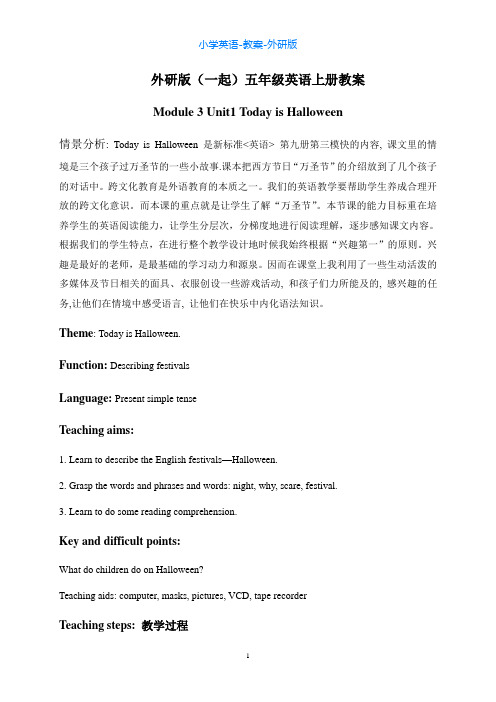
外研版(一起)五年级英语上册教案Module 3 Unit1 Today is Halloween情景分析:Today is Halloween 是新标准<英语> 第九册第三模快的内容, 课文里的情境是三个孩子过万圣节的一些小故事.课本把西方节日“万圣节”的介绍放到了几个孩子的对话中。
跨文化教育是外语教育的本质之一。
我们的英语教学要帮助学生养成合理开放的跨文化意识。
而本课的重点就是让学生了解“万圣节”。
本节课的能力目标重在培养学生的英语阅读能力,让学生分层次,分梯度地进行阅读理解,逐步感知课文内容。
根据我们的学生特点,在进行整个教学设计地时候我始终根据“兴趣第一”的原则。
兴趣是最好的老师,是最基础的学习动力和源泉。
因而在课堂上我利用了一些生动活泼的多媒体及节日相关的面具、衣服创设一些游戏活动, 和孩子们力所能及的, 感兴趣的任务,让他们在情境中感受语言, 让他们在快乐中内化语法知识。
Theme: Today is Halloween.Function: Describing festivalsLanguage: Present simple tenseTeaching aims:1. Learn to describe the English festivals—Halloween.2. Grasp the words and phrases and words: night, why, scare, festival.3. Learn to do some reading comprehension.Key and difficult points:What do children do on Halloween?Teaching aids: computer, masks, pictures, VCD, tape recorderTeaching steps: 教学过程1. GreetingsHello, boys and girls! Nice to see you again!活动设想:不能忽视“问好”这一环节,教师真诚的微笑,热情的话语,能够鼓励孩子更大胆的开口说英语。
外研版小学英语(新标准一起)二年级下册全册教案
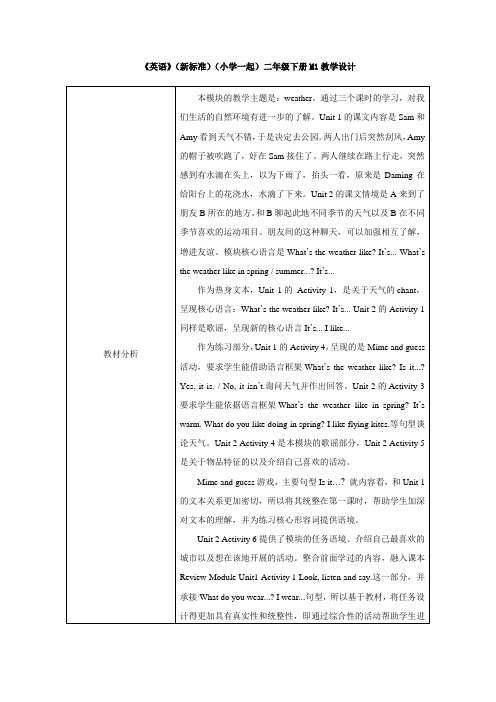
《英语》(新标准)(小学一起)二年级下册M1教学设计2. 全班学生能朗读文本,听说认读:What do you like doing in summer / winter? I like... v+ing. 大多数学生能在情景表演中描述不同季节喜欢的运动,完成Page 6 Activity 3。
技能目标:1. 全班学生能理解对话文本,看图描述对话。
2. 大多数学生能在图片提示和老师的帮助下进行小组活动,描述不同天气和不同的活动。
3. 大多数学生能感知绘本内容和情感,通过小组活动,回顾绘本进行填空练习,培养合作与探究的能力。
情感目标:学生能够通过不同天气,感受到天气对人们生活带来的影响。
通过绘本阅读,感受生活的多姿多态,培养热爱生活的情感。
教学重点与难点教学重点:词汇skiing的音、义、形。
词汇snows的发音。
对不同天气喜欢活动的描述。
教学难点:简单表达自己在不同季节喜欢的活动。
教学辅助PPT课件、CD-ROM、学生练习纸教学策略借助图片或关键词,复述文本;通过活动用书的听力练习和绘本阅读,描述不同天气喜欢的活动,分层次练习、巩固核心语言点,强化文本内容。
教学内容(含时间设置)教学活动设计意图教师活动学生活动Step 1: Pre-task preparation(5 minutes) 1. Free talk:T: What’s theweather like today?T: Let’s review achant.2. Listen and say a1. Review Unit 1and chant last term.2. Enjoy a chant通过思维导图激活学生第一课时的思维图示,借助chant调动学生的思维,引导学生说出打篮球、踢足球、跑步等,为后面的学习做4. Let the students fill in the blanks of the text.5. Retell the story with the help of the mind map. 4.Fill in the blankson the PPT.5. Retell the textaccording to thekey words on thePPT.借助句型框架,分析整理相关文本信息,尝试表达中推进语言的习得情况。
外研社新标准小学英语五年级上册(一年级起点)全册教案

按住Ctrl键单击鼠标打开教学视频动画全册播放Teaching Plan9月1日Teaching Plan9月2日Teaching plan9月7日Revision lesson :9月8日1.通过问答练习,复习there be 句型,掌握其特点。
There is a\an +可数名词的单数\不可数名词There was -—--—----—-—————---—--—-——-—--——--—--—-—- before.There are + 可数名词复数。
There were +可数名词复数before。
做能力培养2.针对出现的问题,及时纠正,3.出错率高的问题,There——-—-——some milk before。
教会学生审题,抓住关键词milk,而不是some.4.在背课文的基础上写作文。
选出好的展示。
5.存在的问题,有的班级整体慢,效率低。
Teaching Plan 9月15日按住Ctrl键单击鼠标打开教学视频动画全册播放Teaching Plan9月16日按住Ctrl键单击鼠标打开教学视频动画全册播放Teaching plan9月21日第4课时:9月25讲练能力:1。
They can well mast this module。
They can spell the words and drills correctly. Most of them can recite the text。
2.But some of them can’t finish the exercises by themselves。
They need help and more practice。
Teaching Plan 9月28日Teaching Plan 9月29日10月9日讲练能力培养1.This module is more difficult for the students。
Some of them can't talk about the western festival correctly and frequently。
小学英语外研新标准二年级上册(2022年新编)Module9It'sWinter教案

Module 9 Unit 1 It*s Winter一、教学目标1、学生能听得懂、会说、会读与季节和气候相关的词汇:Weather, spring, summer, autumn, winter, warm, hot, cool, cold.2、学生能够较为熟练的掌握新句型的听、说、读:Its spring, it's cold.It's summer, it's hot; It's autumn, it's cool; It's winter, it's cold.3、学生能够用所学句型谈论四季的气候,并对季节有初步的感知。
二、学情分析本单元主要涉及四季的表达,不同季节的天气以及四季的穿着,涉及内容较多,学生不容易接受,所以我将前两项内容作为单独的一课,先让学生感知四季和天气并扩展到不同季节的标志性色彩,复习颜色的词汇。
三、重点难点1、能够听懂并会说:Ifs spring, it's cold.It's summer, it's hot; It's autumn, it's cool; It's winter, it's cold.2、能够运用所学句子结构,谈论四季的气候。
四、教学用具多媒体,TPR教学法,图片,单词卡,童谣五、教学过程Stepl Warm-up1.GreetingsSing a song about color.T: Good morning , boys and girls.How are you today?Ss: I'm fine , how are you ?T: Tm fine ,too. Thank you! What's the weather like today?(The teacher looksoutside the window.)Ss: It's cloudy today, and it's cold.T: Yeah, it's cold today. Now, everybody, please stand up! Let's sing the colors song together, ok ? Everybody, show me your hands and follow me!T: Wonderful ! All of you did a great job! Sit down, please!Step2 Lead inT: Boys and girls, today we are going to learn something new. And before our today's class ,F11 devide you into three grups ,try your best to get more snowflakes. Ok,first, please look at the power point, what are they?Ss: Green, red, yellow...T: Yes, you are great! They are colors. How many colors can you see,boys? Boys: Four colors.T: Good! And what are they, girls?Girls: They are green, red, yellow and white.T: Great! There are four colors,they are green, red, yellow and white.I like yellow best, how about you? What color do you like best?S1:1 like white!T: Ok, you like white, let's have a look together what will happen when I click it.(Click the “white”, then jump to another pictuer of “winter" )Then teach the new word “winter”. Ss read after the teacher three times, the teacher shows the picture of winter at the same time, and then write the word "winter” on theblackboard.(同时出示冬天的图片和单词,让孩子们对目标词的意思有更好的理解。
外研版小学英语(新标准一起)一年级下册全册教案
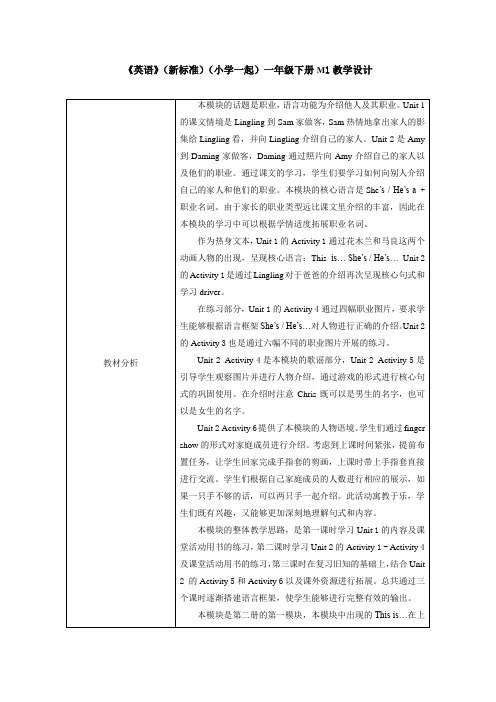
《英语》(新标准)(小学一起)一年级下册M1教学设计Step 4: Extension(7 minutes)Game: My familymember.Show the teacher’sphoto and introduceit as an example.Students talk abouttheir photos ingroups.Introduce familymembers’occupations.Try to learn morewords ofoccupation.让孩子们自带全家福照片,并在小组内交流,目标语言在真实的生活情境中得到充分练习,加深了孩子们对彼此的了解,增进了友谊。
Step5: Summary(3 minutes) What have youlearnt today?Summarize thewords andsentences.让孩子们通过板书学会自己梳理一节课所学,养成良好的英语学习习惯。
Classroom Assessment 1.Good, I like your voice.2.Perfect.3.Great!…及时评价学习过程,通过口头评价,及时反馈学生对知识的掌握情况和本课时的目标达成情况。
家庭作业:基础性作业:Listen and imitate the text for 5 times.拓展性作业:Talk about family members on the photos with friends.板书设计:Module 1 Unit 1 He’s a doctor.She She’s a girl. teacher= She isHe’s a boy. doctor= He isit as an example. Students talk about their photos in groups. Try to learn morewords ofoccupation.生活情境中得到充分练习,加深了孩子们对彼此的了解,增进了友谊。
小学英语新外研版(一起)五年级上册M6U1 教案
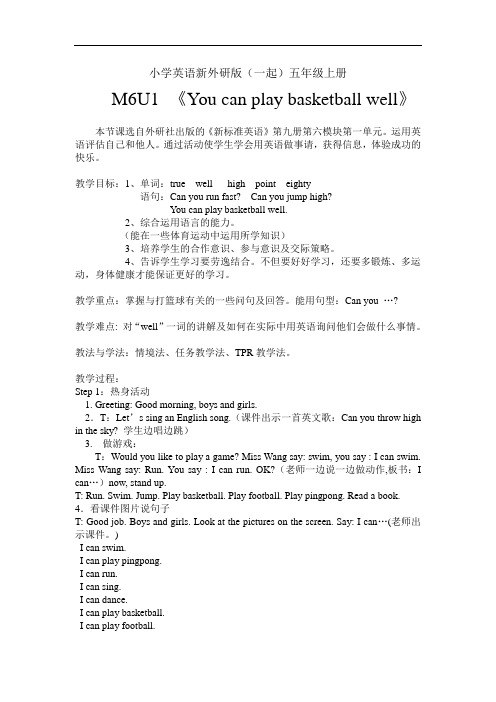
小学英语新外研版(一起)五年级上册M6U1 《You can play basketball well》本节课选自外研社出版的《新标准英语》第九册第六模块第一单元。
运用英语评估自己和他人。
通过活动使学生学会用英语做事请,获得信息,体验成功的快乐。
教学目标:1、单词:true well high point eighty语句:Can you run fast? Can you jump high?You can play basketball well.2、综合运用语言的能力。
(能在一些体育运动中运用所学知识)3、培养学生的合作意识、参与意识及交际策略。
4、告诉学生学习要劳逸结合。
不但要好好学习,还要多锻炼、多运动,身体健康才能保证更好的学习。
教学重点:掌握与打篮球有关的一些问句及回答。
能用句型:Can you …?教学难点: 对“well”一词的讲解及如何在实际中用英语询问他们会做什么事情。
教法与学法:情境法、任务教学法、TPR教学法。
教学过程:Step 1:热身活动1. Greeting: Good morning, boys and girls.2.T:Let’s sing an English song.(课件出示一首英文歌:Can you throw high in the sky? 学生边唱边跳)3. 做游戏:T:Would you like to play a game? Miss Wang say: swim, you say : I can swim. Miss Wang say: Run. You say : I can run. OK?(老师一边说一边做动作,板书:I can…)now, stand up.T: Run. Swim. Jump. Play basketball. Play football. Play pingpong. Read a book. 4.看课件图片说句子T: Good job. Boys and girls. Look at the pictures on the screen. Say: I can…(老师出示课件。
外研版新标准英语六年级上册全册教案(一年级起点)1-9

外研版新标准英语六年级上册全册教案(一年级起点)1ability: students can describe other festivals.moral: love china.重点难点when, what do you do? what do you eat?教学准备tape, pictures, cards.教学环节step1: warmer1. say the poem in module 3 unit22. revise the festival. the teacher say some information about festivals, the students guess which festival it is.3. write the title of module 4.step 2. learn the new words.1. look at the pictures and read them.2. have the students try to make a sentence.3. write the words on the board.4. read again or play the games.step3. listen , point and find fourquestions.1. have the students discuss the information about thankgiving and fill in the blanks.festivalitems thankgiving whendoeat 2. listen and fill in the blanks again.3. listen and repeat.4. listen and repeatagain.5. practice the dialogue in pairs.6. show the results.step4: practice1. the teacher show some pictures of festival and let the students discuss them.2. make a new dialogue.3. make an example.4. show the results.step5. activity book.1. listen and circle the correctanswer.2. listen and complete.step6: homework1. finish the activity book : part 3 and part 4.2. find out information about christmas and make a newspaper in pairs.3. copy the dialogue 2 times.4. draw the picture of christmas.利用猜谜语的游戏引出中国的节日和外国的节日引出 thankgiving 新课。
小学英语新外研版(一起)二年级上册《 What does he do in summer》教案

小学英语新外研版(一起)二年级上册Module 9 Unit 2《What does he do in summer》教案教学目标一、知识与技能1.Students can remember the new words.2.Students can ask someone what does he/she do in spring/summer/autumn/winter.二、过程与方法通过听、说、动作等全身反应的方法,使学生能理解并会用What does he do in summer 句型提问。
三、情感态度和价值观通过创设一定学习情境,激发学生学习英语的热情和兴趣。
教学重点能熟练掌握单词:spring,summer,autumn,winter,goes swimming.教学难点1.关于单三形式的语法点。
.2.会用What does he do in summer?句型提问。
教学方法情景教学法、游戏教学法、讨论交流法。
课前准备多媒体课件、卡片、书本等课时安排1课时。
教学过程一、导入新课Warming upGreetingT: Hello, boys and girls .How are you?Ss: I’m fine, thank you .And you?T: I’m fine too. And how are you feeling today?Ss: Not bad.二、新课学习Step1.Singing a chantListen to the clock.Tick tock, tick tock...Listen to the clock.Tick tock.What’s the time?It’s two O’clock.Listen to the clock.Step2.T: Oh, you are so great. Now, let us review we’ve learned. Ok?Ss: Ok.T: What do you do at the weekend?Ss: I…….at the weekend.T: What do you do in the morning?Ss: I………in the morning.T: What do you have at school?Ss: I have …… and ……T: Show the Ss some books and pictures, include: “Maths”and “Science ”“swimming”“football”“sleep”“Chinese”.Step2.Explain does 是do 的单数形式用于第三人称后面。
一年级上册英语说课稿-Module9-外研社(一起)
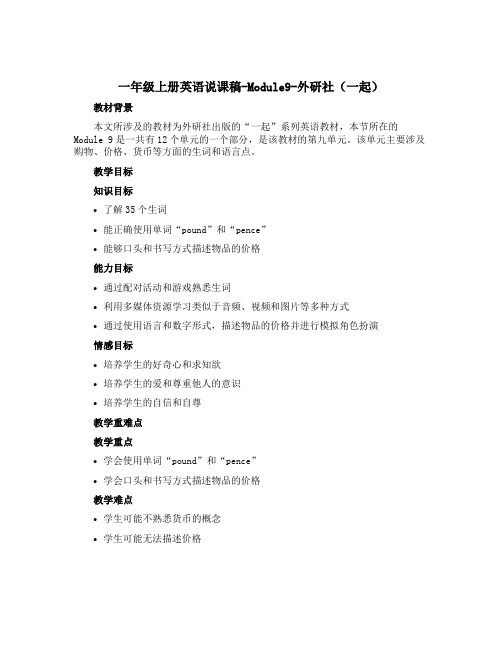
一年级上册英语说课稿-Module9-外研社(一起)教材背景本文所涉及的教材为外研社出版的“一起”系列英语教材,本节所在的Module 9是一共有12个单元的一个部分,是该教材的第九单元。
该单元主要涉及购物、价格、货币等方面的生词和语言点。
教学目标知识目标•了解35个生词•能正确使用单词“pound”和“pence”•能够口头和书写方式描述物品的价格能力目标•通过配对活动和游戏熟悉生词•利用多媒体资源学习类似于音频、视频和图片等多种方式•通过使用语言和数字形式,描述物品的价格并进行模拟角色扮演情感目标•培养学生的好奇心和求知欲•培养学生的爱和尊重他人的意识•培养学生的自信和自尊教学重难点教学重点•学会使用单词“pound”和“pence”•学会口头和书写方式描述物品的价格教学难点•学生可能不熟悉货币的概念•学生可能无法描述价格教学过程导入(5分钟)•利用多媒体资源展示相关图片,出示一些英国常见货币的图片•学生通过观察图片猜测该货币的名称和价值自我介绍(10分钟)让学生课前准备一些关于自己的问题,然后两两配对,彼此相互介绍,如自己的名字、年龄、喜欢玩什么、喜欢吃什么等等,通过交流来激发学生的好奇心,加深学生对英语学习的兴趣和热情。
学习单词(20分钟)•展示图片,并播放音频,让学生熟悉新的生词•利用多媒体资源进行配对活动和游戏,如图片配对游戏、单词连连看等等学习语言点(30分钟)•利用多媒体资源展示相关图片,让学生了解一些常见物品的价格•通过口头和书写方式,让学生练习描述和表示价格,如“He is selling a toy car for 3 pounds”和“It costs 10 pence“•鼓励学生进行练习,可以模拟角色扮演,假装成商家和顾客小结(5分钟)•小结本节语言点和学习内容•让学生再次回顾语言和数字的运用•确认学生是否已经理解相关内容作业布置•让学生回家再次复习本节内容•布置相关作业,如口头描述某个物品的价格或书写某个物品的价格•鼓励学生使用所学知识进行创造性思考教学评估•教师根据学生的口头描述,对其语言水平进行评估•教师根据学生的书写作业,对其语言和数字的掌握程度进行评估•教师根据学生的个人表现和团队表现,对其综合能力进行评估结语本节课主要以生动有趣的方式、多媒体资源等加强学生的英语学习兴趣,增强学生的自信心和贡献意识。
新标准小学英语教案 小学英语教学教案(9篇)
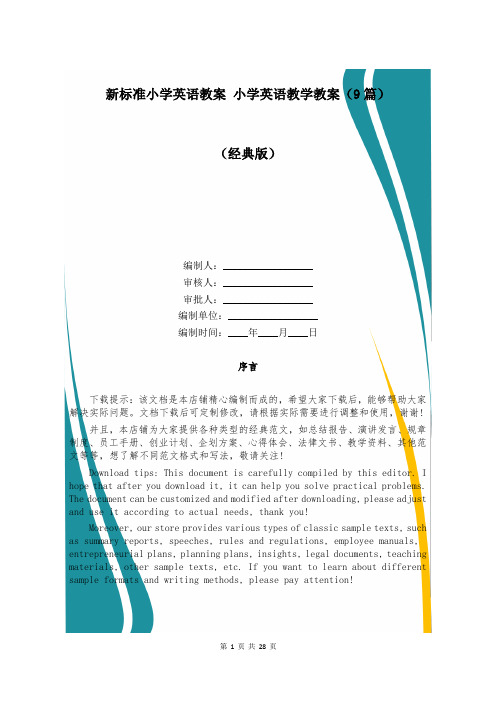
新标准小学英语教案小学英语教学教案(9篇)(经典版)编制人:__________________审核人:__________________审批人:__________________编制单位:__________________编制时间:____年____月____日序言下载提示:该文档是本店铺精心编制而成的,希望大家下载后,能够帮助大家解决实际问题。
文档下载后可定制修改,请根据实际需要进行调整和使用,谢谢!并且,本店铺为大家提供各种类型的经典范文,如总结报告、演讲发言、规章制度、员工手册、创业计划、企划方案、心得体会、法律文书、教学资料、其他范文等等,想了解不同范文格式和写法,敬请关注!Download tips: This document is carefully compiled by this editor. I hope that after you download it, it can help you solve practical problems. The document can be customized and modified after downloading, please adjust and use it according to actual needs, thank you!Moreover, our store provides various types of classic sample texts, such as summary reports, speeches, rules and regulations, employee manuals, entrepreneurial plans, planning plans, insights, legal documents, teaching materials, other sample texts, etc. If you want to learn about different sample formats and writing methods, please pay attention!新标准小学英语教案小学英语教学教案(9篇)作为一位兢兢业业的人民教师,编写教学设计是必不可少的,借助教学设计可以提高教学质量,收到预期的教学效果。
小学英语新外研版(一起)四年级上册M9U2 教案

What happened to this boy/girl?(设计意图:提高兴趣,巩固知识)
2、student’s work book
(设计意图:即使检查反馈学生学习情况)
3、调查:
Name
Accident
T head
Last Monday
关键
积极进行语言实践。
教学
准备
教师
Book,ppt
学生
Books,活动手册
环节
时间
教学内容
师生活动
复案
一、自主感受3
二、自主理解15
三、自主感悟15
四、自主升华7’
导入
新授
拓展
回顾
一、Warmer
1、Make a dialogue:“What day is it today? What’s the weather like today? What day was it yesterday? What was the weather like yesterday?”
Xiaoyong
Cut his finger
yesterday
五、cooler
继续完成调查表
Make dialogues in pairs.
Write the important sentences down.
板书设计
Module 9 Unit 2 I bumped myhead.
bumped myhead
2、Check up the homework.
(设计意图:创设学习氛围,以进一步巩固过去的知识,为新课做准备。)
二、Presentation
1、Lead in:DamingandSamhad an accident,they went to hospital and saw some friends of theirs. What happened to them?let’s find out.
外研版(一起点)二年级英语上册Module9_Unit1 公开课教案
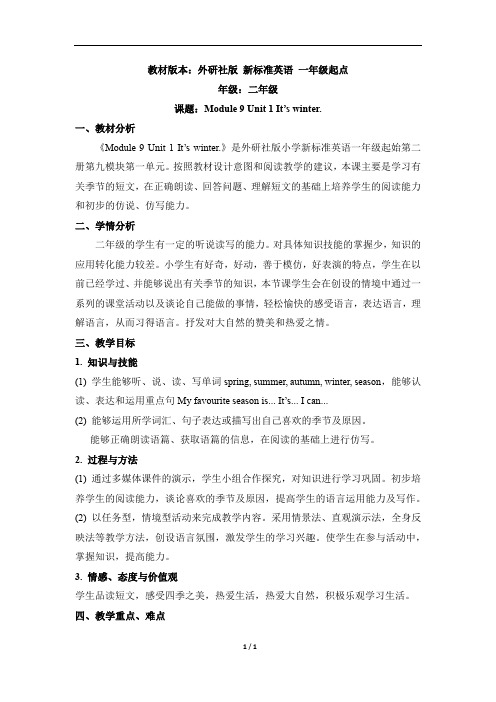
教材版本:外研社版新标准英语一年级起点年级:二年级课题:Module 9 Unit 1 It’s winter.一、教材分析《Module 9 Unit 1 It’s winter.》是外研社版小学新标准英语一年级起始第二册第九模块第一单元。
按照教材设计意图和阅读教学的建议,本课主要是学习有关季节的短文,在正确朗读、回答问题、理解短文的基础上培养学生的阅读能力和初步的仿说、仿写能力。
二、学情分析二年级的学生有一定的听说读写的能力。
对具体知识技能的掌握少,知识的应用转化能力较差。
小学生有好奇,好动,善于模仿,好表演的特点,学生在以前已经学过、并能够说出有关季节的知识,本节课学生会在创设的情境中通过一系列的课堂活动以及谈论自己能做的事情,轻松愉快的感受语言,表达语言,理解语言,从而习得语言。
抒发对大自然的赞美和热爱之情。
三、教学目标1. 知识与技能(1) 学生能够听、说、读、写单词spring, summer, autumn, winter, season,能够认读、表达和运用重点句My favourite season is... It’s... I can...(2) 能够运用所学词汇、句子表达或描写出自己喜欢的季节及原因。
能够正确朗读语篇、获取语篇的信息,在阅读的基础上进行仿写。
2. 过程与方法(1) 通过多媒体课件的演示,学生小组合作探究,对知识进行学习巩固。
初步培养学生的阅读能力,谈论喜欢的季节及原因,提高学生的语言运用能力及写作。
(2) 以任务型,情境型活动来完成教学内容。
采用情景法、直观演示法,全身反映法等教学方法,创设语言氛围,激发学生的学习兴趣。
使学生在参与活动中,掌握知识,提高能力。
3. 情感、态度与价值观学生品读短文,感受四季之美,热爱生活,热爱大自然,积极乐观学习生活。
四、教学重点、难点教学重点:1. 进一步巩固有关季节的单词和句型spring, summer, autumn, winter, season.My favourite season is...I love... it’s... I can wear...2. 指导学生在理解的基础上有感情的朗读课文。
外研版(一起)三年级英语上册《Module 9 Unit 1》教案设计
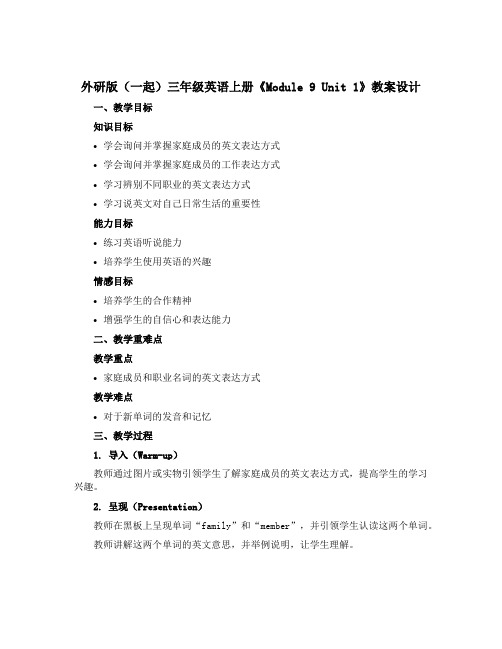
外研版(一起)三年级英语上册《Module 9 Unit 1》教案设计一、教学目标知识目标•学会询问并掌握家庭成员的英文表达方式•学会询问并掌握家庭成员的工作表达方式•学习辨别不同职业的英文表达方式•学习说英文对自己日常生活的重要性能力目标•练习英语听说能力•培养学生使用英语的兴趣情感目标•培养学生的合作精神•增强学生的自信心和表达能力二、教学重难点教学重点•家庭成员和职业名词的英文表达方式教学难点•对于新单词的发音和记忆三、教学过程1. 导入(Warm-up)教师通过图片或实物引领学生了解家庭成员的英文表达方式,提高学生的学习兴趣。
2. 呈现(Presentation)教师在黑板上呈现单词“family”和“member”,并引领学生认读这两个单词。
教师讲解这两个单词的英文意思,并举例说明,让学生理解。
3. 练习(Practice)教师通过图片或实物让学生练习家庭成员的英文表达方式,并分别由学生口语模仿和词汇拼写。
教师组织学生分组,让学生在小组内相互询问家庭成员的英文表达方式,并讲解正确的发音和用词。
4. 呈现(Presentation)教师在黑板上呈现职业名称的英文表达方式,引领学生认读并学习。
教师通过图片或实物展示不同职业的形象和工作内容,并帮助学生理解和记忆相应的英文表达方式。
5. 练习(Practice)教师组织学生分组,让学生在小组内相互询问对方家庭成员的职业,并正确运用新学习的英文表达方式。
教师通过“职业探秘晚会”等形式,让学生模仿不同职业的英文介绍和演练,提高学生的听说能力和自信心。
6. 总结教师带领学生总结本课所学的知识和技能,让学生形成对学习内容的认识和理解。
教师提醒学生将所学内容应用到实际生活中,提高学生的学习兴趣和学习效果。
四、教学评估评价方式教师通过观察学生在学习过程中的表现和听说能力的提高程度来评估学生的学习效果。
评价内容•学生对家庭成员和职业名称的英文表达方式的掌握程度•学生在小组内的表现和合作精神•学生的英语口语和听力水平。
- 1、下载文档前请自行甄别文档内容的完整性,平台不提供额外的编辑、内容补充、找答案等附加服务。
- 2、"仅部分预览"的文档,不可在线预览部分如存在完整性等问题,可反馈申请退款(可完整预览的文档不适用该条件!)。
- 3、如文档侵犯您的权益,请联系客服反馈,我们会尽快为您处理(人工客服工作时间:9:00-18:30)。
Module 1 Unit 1 Total 2 lessonsTitle:There wasn’t a pond.Teaching contents:year before duck playgroundTeaching aims:At the end of the lesson, the students should know new words.At the end of the lesson, the students should grasp past tense and “there be”sentence structure.Teaching points:The students should grasp past tense and “there be”sentence structure.Teaching aids:Some cards, a tape, a recorder…Teaching procedure:1. Warmera. Greeting.b. Continue to do the oral duty by turns.c. RevisionAsk Ss to spell the words,and ask individuals to write down on th eblackboard.Ask someone to make sentence with” there wasn’t,there weren’t,there is ,there are”.2. Presentationa. T draws a picture on the blackboard: It is about a playground.a swing and two slides.There is a pond on the right.There are som e ducks in the water.Please answer the questions: What can you s ee in the picture?b. T is going to say: Sam,Lingling and Amy are the park now.It’s very beautiful park in London .Let’s go to see it.Watch the vedio and tell me what there was before? What was the re now?c. Sen tence pattern: There weren’t any swings here before.There was only a slide. There wasn’t a pond here before before!There’s a pond.There are ducks,too.d. Ask children to open their Activity Books to Page 2 and read the sentences and then decide if they are true or false.3. Practicea. Play the tape again and ask students to read after tape one by one. Devide the class into two parts.Give each two groups a role read the text.b. Devide the class into two parts.Give each two groups a role.c. Ask Ss to look at the pictures of Exercises 2. and look at the f alse sentences in Exercises1.Ss have to find the pictures that mat ch each false statement. Then Ss must write the number of the se ntence in the box under the picture.d. T:Now,class,in exercise 3 you have to write correct sentence un der each picture.Read ten example again under Picture1.e. Look at Exercise 4 and going play the tape.Ask children to liste n.Blackboard designTips: Module 1 Unit 2 Total 2 lessonsTitle:There are tall trees.Teaching contents:year before duck playgroundTeaching aims:At the end of the lesson, the students should know new words.At the end of the lesson, the students should grasp past tense and “there be”sentence structure.Teaching points:The students should grasp past tense and “there be”sentence structure.Teaching aids:Some cards, a tape, a recorder…Teaching procedure:1. Warmera. Greetingb. Show the students’sialogueGive the Ss some words and make sentencesc. Try to recite the words and setence patternd. Take out two different colours’box.one is red and one is b lue.a nd put the apple,banana,book,pen,pencil box in it.The red box is e mpty.Ask Ss come to the blackboard and touch the blue box and ask what’s in the box?e. Then T take something from the blue box and put it the red bo x.and ask Ss to touch and say:There was/There were.2. Presentationa. T: Class.I’d like you to open your Ss’ Books to Unit 2.Activit y 1.Look at the pictures.what can you see? Look carefully.It’s nota park.It’s a part of a school so it’s called a playgroud.b. Read the word” Playground’’ al l together.There is a small pl ayground and there is a big playground in the pictures. Now pleas e watch the video carefully.and read the sentence by sentence. Th en make some statements about the pictures. You must listen and say “Yes”if they are correct or “No”if they are incorrect.c. The teachers continues to make statements about school and S s respond.d. The students continue the activity in pairs.The teacher walks ro und the room and monitors the pairs3. Practicea. Class,I’d like you to look at Activ ity 2,please What can you se e?Ss: There are two classroom./some small desks and some big des ks/some chairs and blackboards.T: I’d like one studennt to help me.Cai Ying,will you standup ,please.I’m A and you’B.I’m going to look at the Class1 picture.Cai Ying,you’re going to look at the Class 5 picture.We’re going to describe our pictures.Let’s begin.Blackboard designTips:Module 2 Unit 1 Total 2 lessonsTitle:This one is heavy.Teaching contents:heavy, lift, sell, country, sometimes, restaurant Teaching aims:At the end of the lesson, the students should know new words.At the end of the lesson, the students should discribe things in the supermarkets.Teaching points:The students should discribe things in the supermarkets.Teaching aids:Some cards, a tape, a recorder…Teaching procedure:1. Warmera. Go over the places of the parks, schools, zoos etc. And T take out some pictures of the places, then T ask the Ss to talk about them by using the pattern “There be”.b. Read the following words:watermelon, orange, milk, T-shirt, sunglass, toys, fruits, ca kes, CDs, chicken, eggs, biscuits, ice cream….2. Presentationa. Show the title: This one is heavy. Explain the title.b. CAI shows the sentence patterns:We are going to ….There are/There is….Let me help you.c. Learn the new words:supermarket over there put in heavy lift helpfuld. Listen to the tape and try to understand the texta) There are so many foods in the supermarkets.What are the foods?Sweets fruits ice--creamb) Can you use the sentence patterns to express them?There are many sweets there.There are many fruits too.Let me help you. You are helpful.c) Let’s practice. Can you talk about your classroom?There is/ There are….3. Practicea. Listen and repeatRead in different roles. Read by yourself. Try to act it out. Handwriting in the classroomThis one is heavy. There is a bag. There are many apples. Homeworka. Listen and repeat.b. Make sentences:Blackboard designTips: Module 2 Unit 2 Total 2 lessonsTitle: They sell different things.Teaching contents:heavy, lift, sell, country, sometimes, restaurant Teaching aims:At the end of the lesson, the students should know new words.At the end of the lesson, the students should discribe things in thesupermarkets.Teaching points:The students should discribe things in the supermarkets.Teaching aids:Some cards, a tape, a recorder…Teaching procedure:1. Warmera. Say the poem.b. Game: Touch and say. (In the box): an apple, a banana, a book,a pen, a pencil-box ….2. Presentationa. A game (seller and buyers):S1:What do you want?S2:I want….Make an example and practice in pairs and then act it outT separate the class into several groups.Group1 T: They sell cloths. Group2 T: They sell foods.Group3 T: They sell toys. Group4 T: They sell CDs and books. Then ask the Ss to use the patterns to buy the things they like. Sellers: What do you want?Buyers: I want….(Here you are. Thank you.)b. Listen to the tape. Answer the teacher’s quest ions:a) What do they sell at a supermarket in England?b) Are there restaurants at a supermarket?Do the families go to the supermarkets together?3. Practicea. Listen to the tape and read after it several times.a) Listen to the tape.b) Read the text sentences by sentence.c) Talk about the different between English supermarket and C hinese supermarket.b. Listen and repeat, try to recite the text.Handwriting:What do you want?I want a doll.Blackboard designTips: Module 3 Unit 1 Total 2 lessonsTitle: Today is Halloween.Teaching contents:night why Halloween festival scare Easter Teaching aims:At the end of the lesson, the students should know new words.At the end of the lesson, the students should know some festivals of western countries.Teaching points:The students should know some festivals of western countries. Teaching aids:Some cards, a tape, a recorder…Teaching procedure:1. Warmera. Let’s sing a songb. Have a free talk.My favorite festival: Spring Festival, Mid-Autumn Festival, Dragon Boat Festival…2. Presentationa. T: Show up a moon cake. What’s this? When do we eat the moon cakes?S: At Mid –Autumn Festival.T: What do we do at Mid-Autumn Festival? There is an autumn festival in western countries. Do you know what it is?Ss: Halloween.Introduce Halloween to childrenb. Show up a picture , Lingling .Daming .Sam had a funny Halloween, Let’s look.T: What’s this ? S: It’s a mask. Ss put the masks and practise.T:What are they? S: They’re scary clothes. Ss say the word and act. T:Why do the children wear scary clothes? What do you know about Halloween? Let’s listen to the tape.Show up the blackboard:1.What’s Halloween? 2.What do children wear? 3.Where do children go? 4.What do children do? 5.What do people do?Listen to the radio tape more and try to answer. Pair work and discuss the questions.3. Practicea. Look at the pictures and describe Halloween.b. Pair work. Play the dialogue in rolesc. There are so many festivals no matter what in China or in west countries. Can you tell me more about festivals?Blackboard designTips: Module 3 Unit 2 Total 2 lessonsTitle:Easter is in spring.Teaching contents:night why Halloween festival scare Easter Teaching aims:At the end of the lesson, the students should know new words.At the end of the lesson, the students should know some festivals of western countries.Teaching points:The students should know some festivals of western countries. Teaching aids:Some cards, a tape, a recorder…Teaching procedure:1. WarmerT: Hello, boys and girls. Are you interested in festivals Please listen and guess, what festival is itSs: Chinese New year, Halloween, Christmas, Children's DayT: Good. Can you tell me any other festivalsSs: Teacher's day, Mid-autumn day, father's day, mother's day, dragon boat festival, National day2. Presentationa. T:"Today we're going to learn another festival. You try to read the passage by yourselves on page 12.Then tell me what festival is it."b. T: Please read the text again, then try to answer my questions. Show questions: "When is Halloween ""What do children do at Halloween ""What do people do "c. Students answer questions, then they come to the front to show their files about Halloween.d. Students practice in group then try to make questions about today's passage. Then they can ask other groupers in turn.For example: Are there toy chicks and flowers on the hats ( y)Is Easter in autumn ( n)People give children chocolate eggs.(y)All the eggs are big.(n)3. Practicea. Play a game: Easter Hunt. The teacher show a passage which need to fulfill the blanks. Students who can fill in the blank with right words and right spell can go around the classroom to find chocolate eggs which the teacher had hidden before the students came in.b. Try to use "wh" to ask questions. For example: "What do they eat on Easter " "Why is there the Easter " "Where do they go on Easter "."When is Easter”Blackboard designTips:Module 4 Unit 1 Total 2 lessonsTitle: We’re going to sing and dance.Teaching contents:invitation reply tidy up be going to…Teaching aims:At the end of the lesson, the students should know new words.At the end of the lesson, the students should know how to use “ be going to…”Teaching points:The students should know how to use “ be going to…”Teaching aids:Some cards, a tape, a recorder…Teaching procedure:1. Warmera. Greetings: Hello, boys and girls.b. Free talk: (1) How many months are there in a year? What are they?(2) Spring Festival is in January or February.When is Halloween/Easter/National Day?2. Presentationa. My birthday is in February. When is your birthday?What are you going to do on your birthday?b. T shows pictures and ask“Are you going to …?T: Say the phrases and stick them on the blackboard.Sing and dance, We’re going to sing and dance .OK?Then write it on the board.c. T shows an invitation and ask :What’s this ?It’s an invitation. Thi s is Amy’s birthday invitation.What does it say? Who can read it?T: Amy is going to be 11.She wants to invite Lingling to her birthday party. Do you know how does Amy want to congratulate her birthday? Now let’s have a look!3. Practicea. Show the questions and read:(1) What are they going to do ?(2) What’s Mum going to do ?(3)What are they going to do after lunch?b. Listen and think over the questions.c. Talk about the questions in your groups.d. Answer the questions, then find out and read the sentences.(1) They are going to have lunch together.(2) Mum’s going to make a birthday cake for Amy.(3) After lunch, they are going to sing and dance.5.Have you found other sentences? (It’s the future tense, be goingto …)T: How many? Read together.Blackboard designTips:Module 4 Unit 2 Total 2 lessonsTitle: Amy is going to be 11.Teaching contents:invitation reply ti dy up be going to…Teaching aims:At the end of the lesson, the students should know new words.At the end of the lesson, the students should know how to use “ be going to…”Teaching points:The students should know how to use “ be going to…”Teaching aids:Some cards, a tape, a recorder…Teaching procedure:1. Warmera. greetings: say hello to teacherb. ask and answer: What are you going to do this weekend? I’m going to …c. free talk: What’s the date? What day is today? ( review the monthand the day)2. Presentationa. S: What are you going to do?T: I’m going to Amy’s birthday party. Look it’s an invitation to her birthday party.Show the invitation card and play the cassette, then answer the questionHow old is Amy going to be? Amy is going to be 11.b. listen again and answer the questionsWhere are we going to go? When are we going to go?c. listen and repeat: students try to read the sentences and mime the soundsretell the passage_____ is going to be _____. Please come to ______ party.At:_______ Road, London.From:______3. Practicea. write an invitationstudents try to write an birthday invitation in activity book.b. do a survey: What are you going to do this weekend?A: Tomorrow is Saturday. What are you going to do?B: I’m going to …c. listen and writefill in the blanks. Discuss in groups and write the answer.d. game: play and saypoint to a student in random and say “ January” and point to the next and say “ February” and so on. Students should pay attention to the order and answer who is belong to the month.e. Activity: show twelve months and put in disorder. Students take the cards and answer the month questions.Blackboard designTips:Module 5 Unit 1 Total 2 lessonsTitle: It’s mine.Teaching contents:mine yours hers his both whose skirt laughTeaching aims:At the end of the lesson, the students should know new words.At the end of the lesson, the students should use possessive pronoun. Teaching points:The students should use possessive pronoun to make sentence. Teaching aids:Some cards, a tape, a recorder…Teaching procedure:1. Warmera. Sing the song. You know up to June.b. What are you going to do? We’re going to …2. Presentationa. Show a box : What’s in the box? It’s a T-shirt. This T-shirt i s too small for me. It’s not mine. Is it yours? Whose T-shirt is th is?b. Ask Ss to look at their books. Listen to the tape and try to fin d the answer: It’s Lingling’s T-shirt. Yes, it’s hers. But where are Sam’s T-shirt and Lingling’s T-shirt.c. Listen to the tape again and try to answer these questions: Is t his Sam’s T-shirt? Not it isn’t. This is Sam’s T-shirt. It’s hi s. Is this Amy’s T-shirt? No, it isn’t.d. Play the cassette again. Pause after each utterance for the child ren to point at the corresponding picture.e. Play the cassette again. Ask the students to repeat.f. Play the cassette again. Ask the children to find “mine” and try to make some sentences.3. Practicea. Listen to the tape and say the sentence.b. Explain and practice: Read row by row.c. Practice in pairs. Then check.Activity in groupsPoint and say: Whose bag is it? It’s hers.First together, then in groups and check them.Do the exercises in activity booka. Read and circle.b. Listen and match.c. Now point and say.d. Listen and repeat..Blackboard designModule 5 Unit 2 Total 2 lessonsTitle: Amy’s blue dress is wet.Teaching contents:mine yours hers his both whose skirt laughTeaching aims:At the end of the lesson, the students should know new words.At the end of the lesson, the students should use possessive pronoun. Teaching points:The students should use possessive pronoun to make sentence.Teaching aids:Some cards, a tape, a recorder…Teaching procedure:1. Warmera. Greetingb. Ask the Ss to act out the dialogue in Unit 1.c. The teacher picks up things of different Ss and say the sentences using the possessive adjective+noun and get the Ss to say the same sentences using the possessive pronoun.Eg: T (pick up a book): It’s his book.The Ss act out the dialogue.The Ss say the same sentences using the possessive pronoun.Ss: It’s his.2. Presentationa. (The teacher puts her book on a student’s desk before class)T: Today we’re going to learn Module 5 Unit 2. Please open your books.(The teacher pretends to miss her book)T: Where’s my book? (Point to a student’s book) Is this book mine? (The teacher pretends to find the book)T: Ah! This book is mine. My book is old. What about your book?The teacher asks the Ss to describe other things.The Ss open their books.S: No, it isn’t yours./No, it’s mine.S: My book is …The Ss describe other things, such as: pen, ruler, clothes etc.b. Look and sayShow the Ss the pictures in Part 2 and ask the Ss to describe them.3. Practicec. Listen and repeatShow the Ss the picture in Part 1and do the listening exercise.Play the tape again and ask the Ss to repeat.The teacher reads the first part of a sentenceGet the Ss to say something about the picture.Blackboard designTips:Module 6 Unit 1 Total 2 lessonsTitle: You can play basketball well.Teaching contents:well true point team thirty-six run fast catch the ball jump high play basketball wellTeaching aims:At the end of the lesson, the students should know new words.At the end of the lesson, the students should use the sentence structure to affirm others’ abilities.Teaching points:The students should use the sentence structure to affirm others’ abilities.Teaching aids:Some cards, a tape, a recorder…Teaching procedure:1. Warmera. Greeting: Good morning, boys and girls.b. Let’s say the poem.c. Would you like to play a game? I will say: swim, you say : I can swim. T: Run. Swim. Jump. Sing. Dance. Play basketball. Play football. Play pingpong.2. Presentationa. Let’s play a game. I am going to do some actions. Look at me carefully and guess what can I do? Use “ Can you…?” to guess:(on the board: Can you…? Yes, I can. No, I can’t.)Show the picture of LiuXiang. T: Who is he?Ss: He is Liuxiang.T: Can he run fast?Ss: Yes, he can. He can run very fast.Ask other students. T: Can you run fast?Ss: Yes, I can. (No, I can’t.)The same way to teach “ jump high, play basketball well, ”T: Now This time I want some students come here and do some actions. Other students use “ Can you…?” to guess.. 3. Practicea. Boy and girls, we are going to have a sports meeting. Here is a survey form. Please finish it. The group leaders do a survey for me. You can ask like this: Can you…? If he/she can do it, draw a happy face, if not, draw a sad face.Blackboard designTips:Module 6Unit 2 Total 2 lessons Title: They got fifty points.Teaching contents:well true point team thirty-six run fast catch the ball jump high play basketball wellTeaching aims:At the end of the lesson, the students should know new words.At the end of the lesson, the students should use the sentence structure to affirm others’ abilities.Teaching points:The students should use the sentence structure to affirm others’ abilities.Teaching aids:Some cards, a tape, a recorder…Teaching procedure:1. Warmera. Greeting:T: Good morning, boys and girls. What’s the weather like?b. Say a chant together.Run, run, can you run? Jump, jump, can you jump? Swim, swim, can you swim?Fly, fly, can you fly?c. Announce the match in this class. (Divide the whole class in two teams: Bull team, Rockets team) Teach the word “team”, read and spell it.d. Number games. (CAI)Ss look at the screen, tell what number is missing. Review the numbers.Show the the number of pictures and count the numbers as fast as possible.2. Presentationa. CAI show a basketball picture, Ss look and answer:What are they doing? How many points did they get?Teach the word “point”, Ss read and spell it.b. Use the mask of Sam to lead in the text.Ss turn to P24, listen to the tape twice, find out the new words, and then answer the questions. CAI shows the questions, Ss answer them.c. Choose out the numbers in the text, Ss read them.d. Ss read the text after T. Read it after the tape. Then read the text together.3. Practicea. Activity: Have an interesting sports meeting.Ss have a match between 2 teams. Ss play basketball/ ping-pong ball/ skipping rope……T ask Ss come to Bb to have matches.b. Practice the drill:T ask Ss “How many points did he/ she get?”Ss answer with “He/ She got ______ points”.c. Sing a song. Ss sing the song of part 3.Blackboard designTips: Module 7 Unit 1 Total 2 lessonsTitle:This dog can help him.Teaching contents:blind special hear fire inside safe Teaching aims:At the end of the lesson, the students should know new words.At the end of the lesson, the students should use the modal verbs—can/ could /can’t to describe the pictures.Teaching points:The students should use the modal verbs—can/ could /can’t to describe the pictures.Teaching aids:Some cards, a tape, a recorder…Teaching procedure:1. WarmerT: What can you do ? Ss: I can…T: Can you …?Ss: Yes, I can. / No, I can’t.2. Presentationa. T: I can draw pictures.W hat can the dog do?/ What can’t the dog do?Ss: This dog can…This dog can’t…Write down the sentences on the blackboardb. show a TV about guide dogT: What can you see on the TV?Ss: I can see a man and a dog.T: Look at the man. He is special. He can’t see. He is blind.This dog can help him. It’s a special dog.Learn new words: blind, specialc.learn the textshow a TV reporterT: This TV presenter is talking about them. Listen carefully and answer questions: Are they in China? Who can help the blind people?Listen to the tape and answer the questionsAmy has a dog named Fifi. Can Fifi help the blind people?Listen and repeat.Read and find the sentences with “can”, “can’t”.3. PracticeT: This dog can help the blind people. What about other animals? What can they do? What can’t they do?Group work: Ss: This panda can…This bird can’t…Blackboard designTips:Module 7 Unit 2 Total 2 lessonsTitle: It could hear the people.Teaching contents:blind special hear fire inside safe Teaching aims:At the end of the lesson, the students should know new words.At the end of the lesson, the students should use the modal verbs—can/ could /can’t to describe the pictures.Teaching points:The students should use the modal verbs—can/ could /can’t to describe the pictures.Teaching aids:Some cards, a tape, a recorder…Teaching procedure:1. Warmera. Sing the of Module 6.b. Revisionlook at the pictures and use can or can’t to make sentencese.g. The panda can ride a bike.c. Game: Put some pictures in a box and get the Ss to speak out what they can do.2. Presentationa. introduce the fireman and the special dog.b. Listen and repeat the text.c. Listen to the tape. Answer the teacher’s questions:What was happened? Was it dangerous for the people?Can the fireman see the people? Who can help the people?d. Listen to the tape and read after it several times.a)Listen to the tape.b)Read the text sentences by sentence.c)Make a short passage by themselves.e. ( CAI shows some pictures.) practice the different tense with th en and nowe.g. She couldn’t speak then. She can speak now.practice in pairs and then say the sentences with partner3. Practicea. sing the song: Fifi was a cute dog.Read the sentences and follow the tapeThen sing the song togetherb. do the exercises in activity bookHandwritinghelp the bilnd people ride a bike find people play basketball o pen the door catch the ballBlackboard designTips:Module 8 Unit 1 Total 2 lessonsTitle: They sit around tables.Teaching contents:line morning exercises miss break study Teaching aims:At the end of the lesson, the students should know new words.At the end of the lesson, the students should know the differences of school between China and England.Teaching points:The students should know the differences of school between China and England.Teaching aids:Some cards, a tape, a recorder…Teaching procedure:1. Warmera. Sing the song. Fifi was a cute dog.b. Review: This dog can help the blind people.2. Presentationa. Ask Ss to look at their books. Listen to the tape and try to un derstand.b. Listen to the tape again and try to answer these questions: Ho w do we sit? How do they sit in England? When does our school start and finish? When does their school start and finish?c. Play the cassette again. Pause after each utterance for the child ren to point at the corresponding picture.d. Play the cassette again. Ask the students to repeat.e. Play the cassette again. Ask the children to try to find “they” and “we”f. discuss in groups what are the differences of school between China and England.e.g. In England, they start school at 9 o’clock and finish at half past 3. The children sit around tables. They sing songs together every morning. In China, we start school at 8 o’clock and finish at 4 o’clock. We sit in lines. We do morning exercises.g. tell children some living customs of the western children3. Practicea. Listen to the tape and say the sentence.b. Explain and practice: Read row by row.c. Practice in pairs.d. Then T reads out and checks the children to point.e. Look at the pictures and say the sentences: In England, they st art school at 9 o’clock.In China, we finish school at 4 o’clock.f. First together, then in pairs and check them.g. Read. Then write England or China.h. Now match the sentences in Exercise 1 to the pictures. Write t he numbers.i. Draw the times on the clock. Then write.Blackboard designTips:Module 8Unit 2Total 2 lessonsTitle:There are lots of games.Teaching contents:line morning exercises miss break study Teaching aims:At the end of the lesson, the students should know new words.At the end of the lesson, the students should know the differences of。
